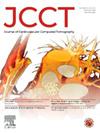低内皮剪切应力与急性冠脉综合征患者冠状动脉粥样硬化斑块活性增加有关。
IF 5.8
2区 医学
Q1 CARDIAC & CARDIOVASCULAR SYSTEMS
引用次数: 0
摘要
背景:冠状动脉粥样硬化斑块活性和低内皮剪切应力(ESS)均可预测心血管不良事件。我们的目的是研究它们与高危斑块特征的关联和关系。方法:采用基于冠状动脉计算机断层造影(CCTA)的血流模拟来计算急性冠状动脉综合征患者进行经皮冠状动脉介入治疗时的ESS。通过18f -氟化钠(18F-NaF)正电子发射断层扫描(PET)在冠状动脉段和血管水平上测量ESS、CCTA斑块特征和冠状动脉斑块活性之间的关系。结果:对330个冠状动脉段和123条血管的ESS和冠状动脉斑块活性进行了分析。低ESS (18F-NaF阳性区域)面积从节段水平的中位数11.7 mm2 (IQR: 4.6-27.4)增加到29.0 mm2 (IQR: 14.1-55.2) (p2 (IQR: 8.6-65.3)到血管水平的57.8 mm2 (26.6-108.2) (P = 0.0049)。在段水平上,18F-NaF活性的最大组织背景比与LSA呈正相关(rs = 0.27;P s = 0.38;结论:在急性冠状动脉综合征患者中,通过18F-NaF PET测量,LSA与冠状动脉粥样硬化斑块活性增加有关。本文章由计算机程序翻译,如有差异,请以英文原文为准。
Low endothelial shear stress is associated with increased coronary atherosclerotic plaque activity in patients that presented with acute coronary syndrome
Background
Both coronary atherosclerotic plaque activity and low endothelial shear stress (ESS) are predictive of adverse cardiovascular events. We aimed to investigate their association and relationship with high-risk plaque features.
Methods
Coronary computed tomography angiography (CCTA) based flow simulations were used to compute ESS in patients presenting with acute coronary syndrome proceeding percutaneous coronary intervention. Associations between ESS, CCTA plaque features and coronary plaque activity, measured by 18F-sodium fluoride (18F–NaF) positron emission tomography (PET), were investigated at the coronary segment and vessel level.
Results
ESS and coronary plaque activity were both analyzed in 330 coronary segments and 123 vessels. The area of low ESS (<0.4 Pa), termed low shear area (LSA), was larger in 18F–NaF positive regions increasing from median 11.7 mm2 (IQR: 4.6–27.4) to 29.0 mm2 (IQR: 14.1–55.2) at the segment level (P < 0.0001) and from median 27.3 mm2 (IQR: 8.6–65.3) to 57.8 mm2 (26.6–108.2) at the vessel level (P = 0.0049). The maximum tissue-to-background ratio of 18F–NaF activity positively correlated with LSA at the segment level (rs = 0.27; P < 0.0001) and at the vessel level (rs = 0.38; P < 0.0001). LSA was associated with spotty calcification at both the segment (P <0.0001) and vessel level (P = 0.0042) and positive remodeling at the vessel level (P = 0.025).
Conclusions
In patients with acute coronary syndrome, LSA is associated with increased coronary atherosclerotic plaque activity, as measured by 18F–NaF PET.
求助全文
通过发布文献求助,成功后即可免费获取论文全文。
去求助
来源期刊

Journal of Cardiovascular Computed Tomography
CARDIAC & CARDIOVASCULAR SYSTEMS-RADIOLOGY, NUCLEAR MEDICINE & MEDICAL IMAGING
CiteScore
7.50
自引率
14.80%
发文量
212
审稿时长
40 days
期刊介绍:
The Journal of Cardiovascular Computed Tomography is a unique peer-review journal that integrates the entire international cardiovascular CT community including cardiologist and radiologists, from basic to clinical academic researchers, to private practitioners, engineers, allied professionals, industry, and trainees, all of whom are vital and interdependent members of our cardiovascular imaging community across the world. The goal of the journal is to advance the field of cardiovascular CT as the leading cardiovascular CT journal, attracting seminal work in the field with rapid and timely dissemination in electronic and print media.
 求助内容:
求助内容: 应助结果提醒方式:
应助结果提醒方式:


